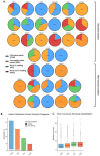This is a preprint.
RNA isoform expression landscape of the human dorsal root ganglion (DRG) generated from long read sequencing
- PMID: 37961262
- PMCID: PMC10634934
- DOI: 10.1101/2023.10.28.564535
RNA isoform expression landscape of the human dorsal root ganglion (DRG) generated from long read sequencing
Update in
-
RNA isoform expression landscape of the human dorsal root ganglion generated from long-read sequencing.Pain. 2024 Nov 1;165(11):2468-2481. doi: 10.1097/j.pain.0000000000003255. Epub 2024 May 16. Pain. 2024. PMID: 38809314
Abstract
Splicing is a post-transcriptional RNA processing mechanism that enhances genomic complexity by creating multiple isoforms from the same gene. Diversity in splicing in the mammalian nervous system is associated with neuronal development, synaptic function and plasticity, and is also associated with diseases of the nervous system ranging from neurodegeneration to chronic pain. We aimed to characterize the isoforms expressed in the human peripheral nervous system, with the goal of creating a resource to identify novel isoforms of functionally relevant genes associated with somatosensation and nociception. We used long read sequencing (LRS) to document isoform expression in the human dorsal root ganglia (hDRG) from 3 organ donors. Isoforms were validated in silico by confirming expression in hDRG short read sequencing (SRS) data from 3 independent organ donors. 19,547 isoforms of protein-coding genes were detected using LRS and validated with SRS and strict expression cutoffs. We identified 763 isoforms with at least one previously undescribed splice-junction. Previously unannotated isoforms of multiple pain-associated genes, including ASIC3, MRGPRX1 and HNRNPK were identified. In the novel isoforms of ASIC3, a region comprising ~35% of the 5'UTR was excised. In contrast, a novel splice-junction was utilized in isoforms of MRGPRX1 to include an additional exon upstream of the start-codon, consequently adding a region to the 5'UTR. Novel isoforms of HNRNPK were identified which utilized previously unannotated splice-sites to both excise exon 14 and include a sequence in the 5' end of exon 13. The insertion and deletion in the coding region was predicted to excise a serine-phosphorylation site favored by cdc2, and replace it with a tyrosine-phosphorylation site potentially phosphorylated by SRC. We also independently confirm a recently reported DRG-specific splicing event in WNK1 that gives insight into how painless peripheral neuropathy occurs when this gene is mutated. Our findings give a clear overview of mRNA isoform diversity in the hDRG obtained using LRS. Using this work as a foundation, an important next step will be to use LRS on hDRG tissues recovered from people with a history of chronic pain. This should enable identification of new drug targets and a better understanding of chronic pain that may involve aberrant splicing events.
Keywords: WNK1; dorsal root ganglion; hnRNPK; long read sequencing; splicing.
Conflict of interest statement
Conflict of interest: The authors declare no conflicts of interest.
Figures









References
-
- Au P. Y. B., Goedhart C., Ferguson M., Breckpot J., Devriendt K., Wierenga K., Fanning E., Grange D. K., Graham G. E., Galarreta C., Jones M. C., Kini U., Stewart H., Parboosingh J. S., Kline A. D., Innes A. M., & Care for Rare Canada C. (2018). Phenotypic spectrum of Au-Kline syndrome: a report of six new cases and review of the literature. Eur J Hum Genet, 26(9), 1272–1281. 10.1038/s41431-018-0187-2 - DOI - PMC - PubMed
-
- Au P. Y. B., Innes A. M., & Kline A. D. (1993). Au-Kline Syndrome. In Adam M. P., Feldman J., Mirzaa G. M., Pagon R. A., Wallace S. E., Bean L. J. H., Gripp K. W., & Amemiya A. (Eds.), GeneReviews(®). University of Washington, Seattle - PubMed
-
- Copyright © 1993-2023, University of Washington, Seattle. GeneReviews is a registered trademark of the University of Washington, Seattle. All rights reserved.
-
- Barragan-Iglesias P., Franco-Enzastiga U., Jeevakumar V., Shiers S., Wangzhou A., Granados-Soto V., Campbell Z. T., Dussor G., & Price T. J. (2020). Type I Interferons Act Directly on Nociceptors to Produce Pain Sensitization: Implications for Viral Infection-Induced Pain. J Neurosci, 40(18), 3517–3532. 10.1523/JNEUROSCI.3055-19.2020 - DOI - PMC - PubMed
-
- Bhuiyan S. A., Xu M., Yang L., Semizoglou E., Bhatia P., Pantaleo K. I., Tochitsky I., Jain A., Erdogan B., Blair S., Cat V., Mwirigi J. M., Sankaranarayanan I., Tavares-Ferreira D., Green U., McIlvried L. A., Copits B. A., Bertels Z., Del Rosario J. S.,. … Renthal W. (2023). Harmonized cross-species cell atlases of trigeminal and dorsal root ganglia. bioRxiv. 10.1101/2023.07.04.547740 - DOI - PMC - PubMed
Publication types
Grants and funding
LinkOut - more resources
Full Text Sources
Miscellaneous
